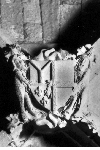The present castle is situated upon the site of the original fortress
built by the Lusignans : no doubt about its ancient origin since it is
said that the "Fairy Melusine" was its ancestor. In the Middle Ages, the
Lusignan family became powerful, allowing one of its branches to ascend
to the throne of Cyprus and Jerusalem at the beginning of the 13th century.
Hugues XI de Lusignan fell out with St. Louis who seized Cherveux in 1242
and gave it to his brother Alphonse, Comte du Poitou. Hugues proved his
allegiance to his lord the king by accompanying him on the crusades. He
died in a battle just after arriving in Egypt in 1249. The castle was given
back to Hugues'descendants, then it passed into the hands of the Mello
family, then the Craon family and finally to that of Chalon. It was then
taken by the English under the reign of Edward III in 1363 and was given
to William of Felton, the Senechal of Poitou. After the conquest of the
province by Duguesclin, Cherveux was returned to the Chalon family whence
it passed to the Tremoille line who in turn sold it in 1457 to Armaury
d'Etissac, lord of Coulonges les Royaux who yielded it to Jean de Naydes
who in his turn sold it to the Chenin family. Their daughter Louise Chenin
married Robert Conningham in May 1440. Of Scottish origin, captain of the
bodyguard of king (extremely well in court at Louis XI) Cunningham (or
Conygham according to texts' of the BNF) had the means to erect the whole
of the present castle in one single effort about 1470. "The Scots and the
French were bound together by the Auld Alliance. The Scots Guard - ‘Garde
Écossaise’ - was founded in 1418 by Charles VII of France. The Scots soldiers
of the Garde Écossaise fought alongside Joan of Arc against England during
the Hundred Years War. In March 1421 a Franco-Scots force under John Stewart,
2nd Earl of Buchan, and Gilbert de Lafayette, defeated a larger English
army at the Battle of Baugé. Three years later, at the Battle of Verneuil,
the Scots lost around 6000 men, including John Stewart.The Garde Écossaise
was seen as an elite military unit. Louis XI of France had them act as
personal bodyguards to the French monarchy. In return for service, Scottish
soldiers were often granted honourable positions and lands in France."
Education scotland.

Cunningham blazon

Later, Cherveux was passed via successive marriages to the Puyguion and St. Gelais families. Although it was a principle, formidable stronghold it was, nevertheless, taken in 1569 by the Marquis of Lude who installed a garrison of swordsmen and then again in 1574 by the Duc of Montpensier. Until the 18th century it was held by the Plessis-Chatillon family who were succeeded by the Narbonne-Pelet family. It was confiscated by the nation of France and sold 3 years after the French Revolution to Pierre Aloneau. Descendants of Aloneau (family Clouzot Meynier) preserved it until 1931 and sold it to Mr and Mrs Redien Lucien, whose family has restored and preserved the castle and farmed the land since 1912. Today it is owned by M. et Mrs Eckel. The castle was listed as an Historic Monument on September 16, 1929.